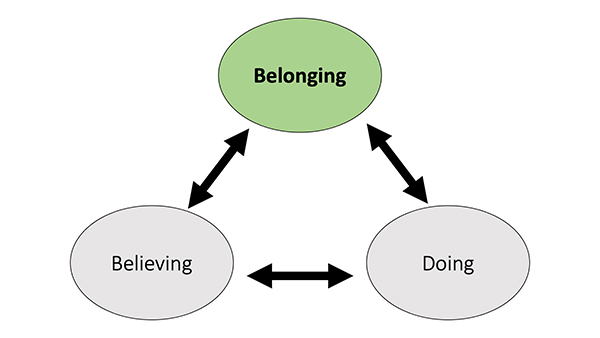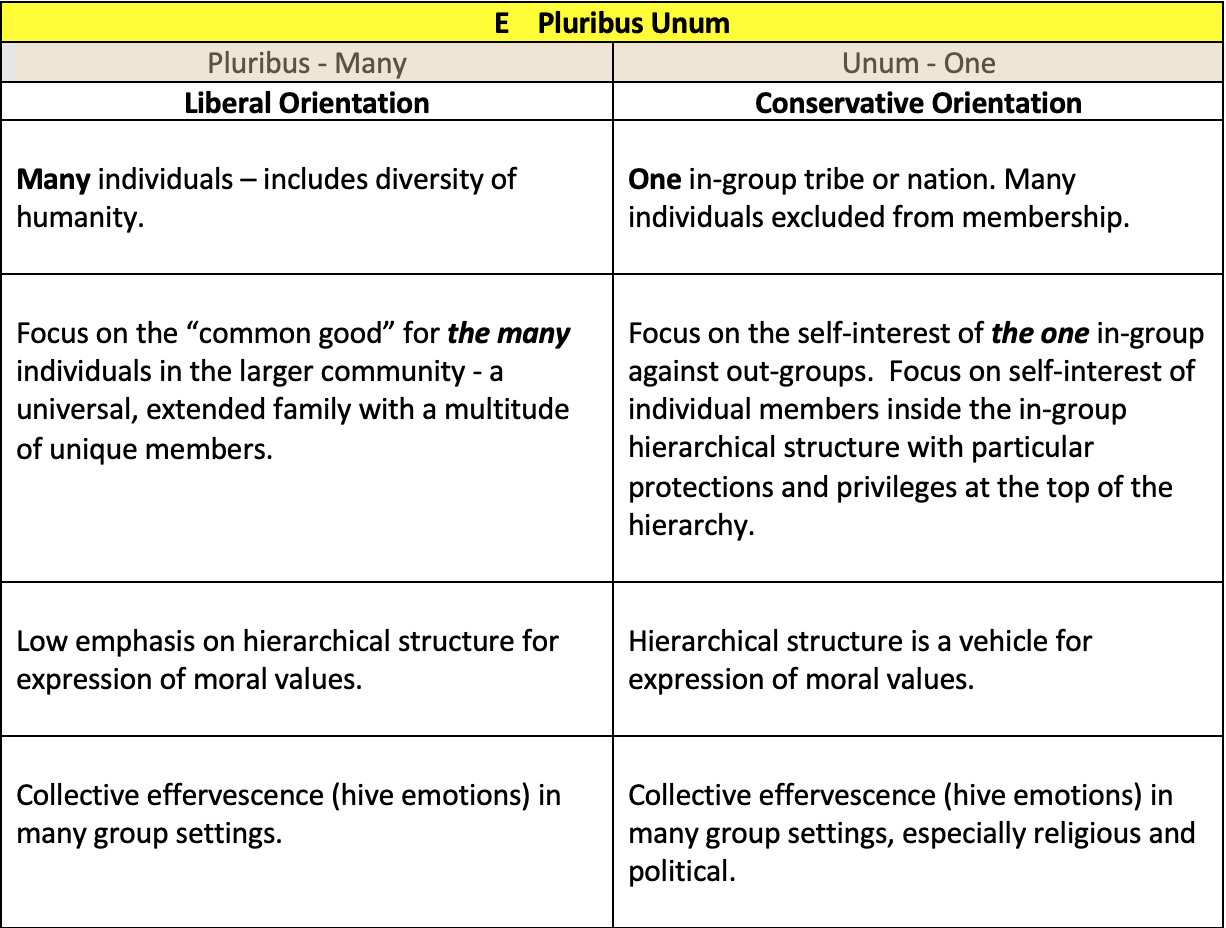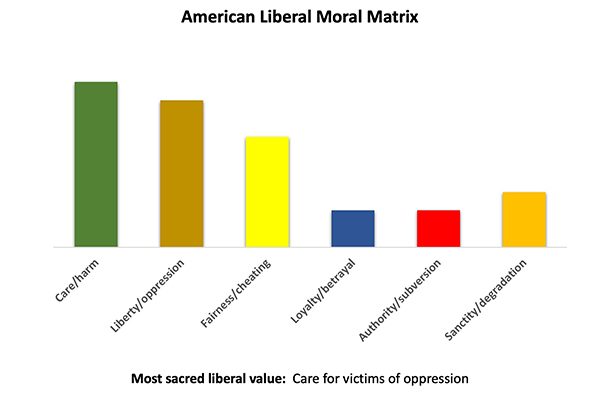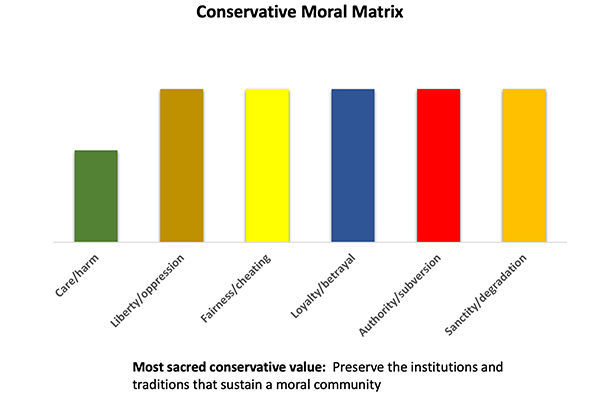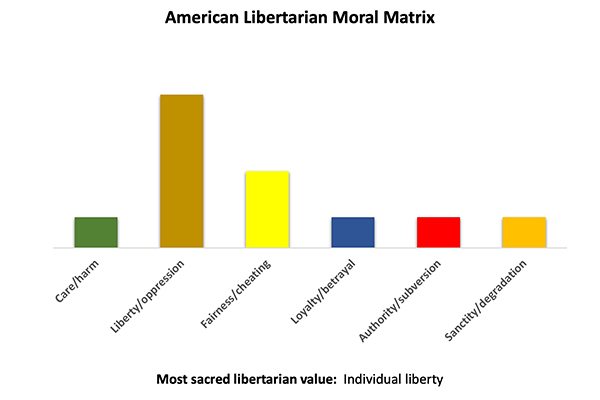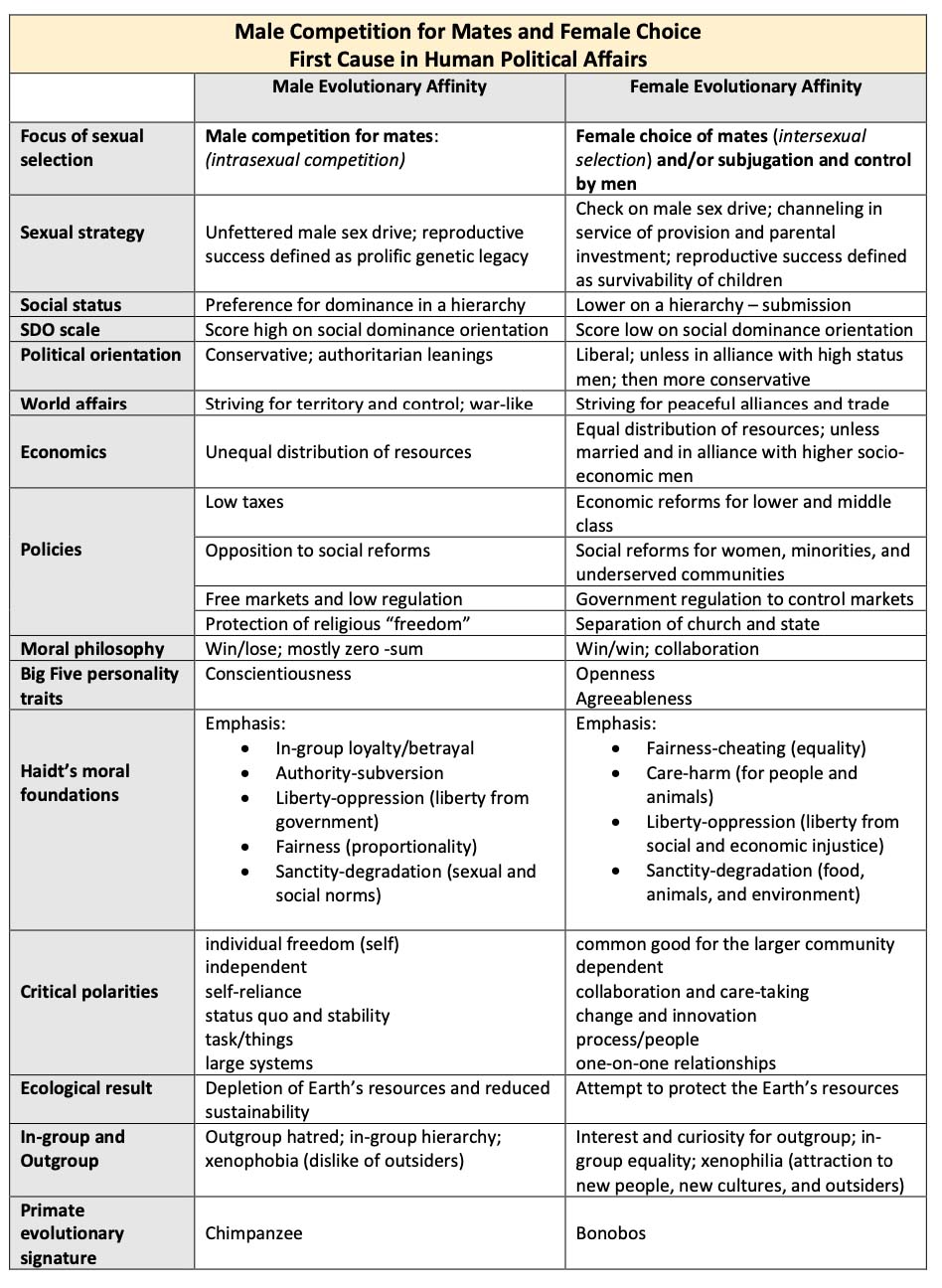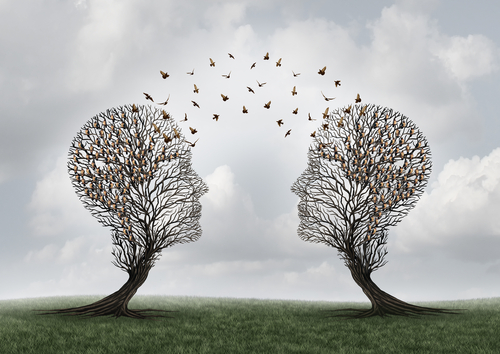
Political Divide – Part 6: “Moral” Communication – The Way Forward
Out beyond ideas of rightdoing and wrongdoing, there is a field. I’ll meet you there.
~ Rumi
Introduction
In these last six posts, I have connected dots from evolutionary psychology and mate selection science to politics (both ancient and current), moral foundation theory, philosophy, cultural critique, and lastly, interpersonal communication. I have shown that the six moral foundations are integral to the evolution of human societies and open a pathway for understanding what liberals and conservatives really care about. I promised that this post would build on the moral foundations and offer a way to close the political divide.
Technology of Communication
Closing the political divide with another person requires magnanimous intent and some dexterity with the “technology” of communication. The communication frameworks and practices suggested here draw upon people-skills training, dialogue practices, facilitation, emotional intelligence, mediation, and conflict resolution.
Listening Experiments
Below is a set of listening “experiments” – thoughts exercises and sentence stems that broaden the possibilities of what you hear from others. The second half of this post includes more observations about the psychological causes of the divide. These insights are entirely relevant for knowing how to communicate across the divide; they unveil much about the nature of human reasoning. The Appendix explains our preoccupation with conspiracy theories and gives a short primer on the rise of post-objectivity in America.
Insights from Part 3 and Part 4 of this Series
Remember the following as you read.
- It is hard to connect with those who live in different moral matrices.
- Look for commonality.
- Some things are sacred to others, as some things are sacred to you.
- Liberals are ambivalent about Authority, Loyalty, and Sanctity. For conservatives, Authority, Loyalty, and Sanctity are sacred.
- Belonging may be the penultimate need of human beings after survival and safety are assured.
Listening Experiments – A Way Forward
Seek first to understand, Then be Understood.
[But] Common Sense is not common practice.
~ Stephen Covey
Empathic Listening – Basic Skill Sets
Thousands of books and training curricula have outlined the following skills for empathic listening. They are foundational for “moral communication” across the political divide.
- Attending and following: eye contact, a posture of involvement, an invitation to talk, and minimal encouragements, such as “tell me more.”
- Paraphrasing content: reflecting essential facts and ideas
- Reflecting feelings: identifying the key emotion expressed by the speaker’s words, body language, and tone. Then reflecting their feelings in your own words.
- Reflecting meaning: reflecting the speaker’s predominant emotion and your understanding of the reason behind their emotion, which may be their perception of the facts or an inferred meaning not yet expressed.
Use Moral Foundations to Reach your Political Opposite.
If you want to understand someone politically different from you, elicit and consider what is sacred to them. Which of the three moral matrices drive their thoughts and feelings? Next, consider which of the six moral foundations carry the most weight in a particular controversy.
Listening to Hear the Sacred Value
Do you hear mostly a concern for the victims of oppression, for those in need? Concern for victims is a sacred value for liberals. Or, do you hear a concern for protecting institutions, traditions, national pride, and the family? Those are sacred values for conservatives. You might also hear the sacred value of liberty and freedom from government. Liberty is a sacred value to many in our nation. Knowing what is sacred is the first step in reaching across the divide.
Build It and They Might Come
A “field of empathy” between “red and blue” can only emerge on the emotional and instinctual level. We might bridge the divide if we connect with the gut feelings of the other side, if we engage with the other tribe long enough to “feel” what it is like to be them. We must walk in their shoes and know their unique lived experience. Creating this field “beyond right-doing and wrong-doing” will not be easy. But build it, and they might come.
Listen to Hear the Emotion
Imagine if your only goal in a conversation was to know what emotions are being expressed by the speaker. In this experiment, you do not care about their “facts” – only their feelings. Are they mostly angry, afraid, or sad? What do their eyes, mouth, torso, and arms communicate? Their nonverbal language will be congruent with their feelings in most cases. Perhaps their emotions shift, moment to moment. In conversations with conflict, there will also be glimmers of curiosity, enthusiasm, joy, and hope. In Nonviolent Communication – A Language of Life (2005), author Marshall Rosenberg names over one hundred feelings that result when our needs are not met. Nonviolent Communication should also be read to understand the distinction between “I feel” vs. “I think” and how the latter is often used to avoid or mask the emotional content.
Emotion is the Conduit
To reach across the political divide and make a human connection, we must be on a shared emotional channel, not the channel of ideas; we must express what we are angry about, afraid of, or sad about, given our sacred values.
By expressing our feelings, we can shape other people’s emotional states and make it more likely that other people will take our point of view. Emotions are incredibly contagious. MRI studies prove that our brains will synchronize when there are emotional words and content. According to Finish neuroscientist Lauri Nummenmaa, brain synchronization allocates attention in the same direction and generates a similar psychological state. Synchronized brains prompt people to act and view the world in a similar way. If persuasion is eventually your goal, get your listener to feel what you feel.
Emotional Bottomline
Don’t trade facts; trade stories. Don’t try to persuade (with exceptions ahead), just listen. Just listen to their story and their pain, and perhaps share some of your own emotional story. Just hear their anger, fear, and sadness. Just be with it.
Reframing Using Moral Foundations
Researchers Robb Willer and Mathew Feinberg did a series of studies to test how to nudge a political opponent to consider ideas they would normally reject. The idea is to appeal to the other’s moral foundations. Willer and Feinberg found that when conservative policies were framed around liberal values, like equality and fairness, liberals became more accepting of them. And when liberal policies were recast in terms of respect for authority, conservatives became more receptive. This reframing technique is far from a panacea – it is tough to convert a political opponent to your side. But research shows reframing can make a small difference to soften a stance and get the other side to listen a bit more.
Example – Military Spending
If a conservative wanted to convince a liberal to support higher military spending, he should not appeal to his patriotism. He should appeal to his Care/harm foundation with something like, “Through the military, the disadvantaged can achieve equal standing and overcome the challenges of poverty and inequality” (liberal foundations of equality, fairness, and protection of the vulnerable).
Example – Kneeling for the Anthem
If you are trying to convince a conservative of the merits of kneeling for the national anthem in protest, emphasize the traditional values around religious and political freedom. Argue that the founding fathers were deeply concerned about protecting our rights to social protest.
Example – Trump and Loyalty
Feinberg found that an argument against Trump in terms of loyalty (loyalty foundation) led conservatives to report less support for him. This message argued that Trump behaved disloyally towards our country to serve his own interests and that during the Vietnam War, he dodged the draft to follow his father into the development business.
Deep Canvassing – Listening to Gently Persuade
A 2016 article in the journal Science described a way to sway prejudicial opinions in a mode of conversation that political organizer, Dave Fleisher, calls “deep canvassing.” This technique is intuitively quite obvious. Let the “voter” do most of the talking. Ask open-ended questions and let them share their own experiences — delve into their personal story about when they felt (as an example) discriminated against. Near the end of the conversation, nudge the person to consider how their story might relate to the pertinent issue. The idea is that people learn lessons more durably when they come to conclusions themselves, not when someone “bitch-slaps them with a statistic,” says Fleischer. The technique boils down to this: listen to people, get them to think about their own experience, and then highlight your common humanity.
Listening Like a Braver Angel
Building on Abraham Lincoln’s appeal to the “better angels of our nature,” Braver Angel red/blue workshops across the country have structured conversations where deep listening might occur. Braver Angel participants seek to understand the experiences of those across the political divide and find possible areas of common ground. The focus is on listening and reflecting, rather than debating and persuading. These workshops do not seek to change minds nor develop a centrist political philosophy. Participants are asked, with earnest curiosity, how they believe their values and policies are good for the country. This kind of listening to the experience of “the other” may allow for understanding and reveal the operation of their moral matrix.
Personality Differences with Deep Listening
A cautionary note is in order. As discovered in an earlier iteration of this bipartisan effort called “Better Angels,” there may be a problem as described by investigative journalist David Graham: “People who are willing to spend a morning or a day on such an exercise are the kind of people who are already convinced that dialogue is important, and are more willing to hear the other side out.” Remember, there are personality differences (noted in Part 1 and Part 2 and reviewed in Part 3) between liberals and conservatives. Liberals are more comfortable with openness, and that includes experiential workshops.
Listening to Hear the Need
A critical contribution from Nonviolent Communication (NVC) is identifying the needs of the speaker behind their feelings. Recognizing the need is extremely important in reaching across the political divide. Rosenberg identifies needs for autonomy, integrity, celebration, interdependence, play, spiritual communion, and physical nurturance. Maslow’s hierarchy remains the benchmark for understanding human needs. The needs of belonging (as emphasized in prior posts) and esteem (respect) are perhaps the most essential needs to acknowledge in our political opposites. Here is a probe suggested by William Issacs (Dialogue – The Art of Listening Together) that may help find the sacred value, the feeling, or the unmet need. Ask: What else must be true (in your world) in order for you to have that position or belief?
Reflecting Meaning Using NVC
Here is a NVC sentence sequence for the reflection of meaning back to the speaker:
“You feel ….angry
when ….people don’t kneel for the flag (action of a person, institution, or an event)
because you want or need to be respected as our nation is respected.
Is that right?” (check for accuracy)
Of course, there is an “I-statement” version of this sentence sequence.
“I feel afraid and angry
when ….police shoot Black people
because I need to feel safe and want the respect given by equal protection and rights.”
Other versions of reflection of meaning include an explanation of the impact and consequences of the behavior (after “because”), sharing and checking assumptions about the other person, and a request for some new action. But it is the NVC version that has the most focus on hearing the feeling and the need, without necessarily including any request or expectation for the person to think or behave differently. (The complete NVC sequence includes a request.)
Listening Without Judgment – A Worthy Aspiration
Indian philosopher J. Krishnamurti once remarked that observing without evaluating is the highest form of human intelligence. The first component of NVC entails the separation of observation from evaluation. It is an aspirational goal. Humans are judgment machines. (Remember, our cautious discernments protected us from cheaters and free-riders for thousands of years.) But with practice (and mostly keeping your mouth shut), it is possible to learn how to listen “without resistance” and the need to critique. It takes a fair amount of internal monitoring and returning to the state of non-judgment – like returning to a mantra or the breath in meditation.
Listening for Collective, Shared Meaning
Each conversation we have across the political divide is like an act in a play. When we listen for collective meaning, we reveal the plot we are enacting. To reach across the political divide, we need to identify common motivations. Listening for the collective, shared meaning informs us about who we are together and who are becoming together. William Isaacs in Dialogue: The Art of Thinking Together, (1999) suggests this thought experiment: “listen for the already existing wholeness.” Linda Ellinor and Glenna Gerard (Dialogue — Rediscover the Transforming Power of Conversation) pose this question: If there were one voice speaking here, what would that voice be saying?
Challenges of Human Reasoning
It is not Rational
We have learned that most political discourse is not about policies or rational thinking. We are in a post-objectivity era of information (see Appendix). We do not share facts. Science has a muffled or even muzzled voice, even in this time of the pandemic. “When gut feelings are present, dispassionate reasoning is rare. Feelings come first and tilt the mental playing field on which reasons and arguments compete. If people want to reach a conclusion, they can usually find a way to do so” (Jonathan Haidt).
Social Media Contact Does Not Bridge the Divide
Researchers at Duke, NYU, and Princeton paid a large sample of Democratic and Republican Twitter users to read more opinions from the other side. The researchers found no evidence that inter-group contact on social media reduced political polarization. Whenever we engage in political debates, we all tend to overrate the power of arguments we find personally convincing – and wrongly think the other side will be swayed.
Messages Do Not Transfer to Another Tribe
Willer and Feinberg underscored what moral foundation theory tells us: messages that excite like-minded voters by appealing to their sacred values do not translate from one moral tribe to another. “You’re essentially trying to convince somebody who speaks French of some position while speaking German to them,” Willer said.
Example – Gun Control
On gun control, for instance, liberals are persuaded by stats like “no other developed country in the world has nearly the same rate of gun violence as does America.” And they think other people will find this compelling. Conservatives, meanwhile, often go to this formulation: “The only way to stop a bad guy with a gun is a good guy with a gun.” Both sides fail to understand that they are arguing a point that their opponents have not only already dismissed but may be inherently deaf to.
Confirmation Bias
We sometimes process information in a manner less like an impartial judge and more like a lawyer working for the mob.
~Douglas Kenrick, et al., Scientific American, Fall 2020
Confirmation bias is the tendency to look for information that confirms our pre-existing beliefs and to interpret information in ways that confirm our preconceptions. We show a natural tendency to pay attention to some findings over others and to reinterpret mixed evidence to fit with what we already believe.
Expecting Malicious Intent
Also, the more we dislike someone or something, the more likely we are to attribute their actions to malice. Whenever someone we dislike makes a mistake, reacting with empathy and understanding tends to be the last response. If we expect malicious intent, we are likely to attribute it wherever possible. Modern media treats outrage as a profitable commodity. These outlets are skilled at generating assumptions of malicious intent. (See post-objectivity era in Appendix.)
Anger is often held in place by a belief that the person has “the intent to do us harm.” If this belief can be dispelled through empathic conversation, anger and hardened positions often subside.
Hanlon’s Razor – Low Level of Intent
Often we are unable to identify when mistakes are the result of incompetence or an accident.
Robert J. Hanlon teaches us not to assume the worst intention in the actions of others. “Hanlon’s razor” says “never attribute to malice that which can be adequately explained by neglect, laziness, or stupidity.” Use with caution inside your own head.
Motivated Reasoning
Along with confirmation bias, humans often use their reasoning to concoct a justification in favor of some belief they hold or to counter an assertion or argument presented against that belief. Researchers Mercier and Sperber (2011) report that human reasoning, deployed in social contexts, evolved not so much as a means of ascertaining truthful propositions, but rather as a way of winning arguments – as a way of persuading others.
Tali Sharot in The Influential Mind debunks the idea that motivated reasoning is a trait of less intelligent people. Indeed, studies show that the greater your cognitive capacity, the greater your ability to rationalize and interpret information at will, to creatively twist data to fit your opinions.
Boomerang Effect
Presenting people with information that contradicts their opinion can cause them to come up with altogether new counterarguments that further strengthen their original view, says Sharot. A burst of counterarguments is known as the “boomerang effect.”
Belief Perseverance
Belief perseverance refers to our quest to maintain what we know as true even after the information has been refuted. Evidence to the contrary will be dismissed, and we are likely to seek and believe information that supports our belief while rejecting any data to the contrary. The “Einstellung Effect” is the brain’s tendency to stick with the most familiar solution to a problem and stubbornly ignore alternatives. (Scientific American, “Why Good Thoughts Block Better Ones”, Fall 2020) Preestablished opinions are difficult to change, even when they are wrong.
Evidence is Rejected
The problem with information and logic is that it ignores the core of what makes you and me human: our motives, our fears, our hopes and desires.
~ Tali Sharot, The Influential Mind
In a 2017 study, Anthony Washburn and Linda Skitka of the University of Chicago tested the hypothesis that conservatives are more distrustful of scientific evidence than liberals. The authors gave 1,347 study participants scientific evidence on six hot button issues – climate change, gun control, health care reform, immigration, nuclear power, and same-sex marriage. Washburn and Skitka found that both conservatives and liberals reject findings that do not align with their political ideologies.
Carrot and Stick
If persuasion is the goal, Sharot’s research makes it clear that we should use a “carrot” (positive rewards) to encourage action and use a stick (punishment) to stop an action or cause inaction. For instance, wearing a protective mask could be increased by counting its use and giving positive feedback instead of delivering messages about preventing sickness and decreasing risk. The human brain is built to associate “forward” action with a reward, not avoiding harm.
Beware of the “Halo Effect”
The “halo effect” is when one trait of a person or thing is used to make an overall judgment of that person or thing. It supports rapid decisions, even if they are biased; it allows us to make snap judgments. Early humans who could make fast decisions were more likely to survive to become our ancestors. We have inherited a tendency to make (overly) quick judgments based on generalizing from a small amount of data.
Don’t Generalize from Their Politics
For example, (as I have reported elsewhere on this site) a tall or good-looking person will be perceived as smart and trustworthy, even though there is no logical reason to believe that height or looks correlate with intelligence or honesty. If you are trying to bridge understanding with a person who is a Trump supporter or a Black Lives Matter protestor (someone opposite of you in affiliation), don’t transfer the fact of their political affiliation (or any easily observed characteristic) to a judgment of that person’s overall character.
Nurture Belonging and the Social Fabric
Cultivate Belonging in a Divided Culture
In my last post (Political Divide Part 5), I noted that belonging is fundamental to human beings; it drives our religious experience and political affiliations. Belonging is more important than beliefs. Belonging is a central need that must be acknowledged in reaching across the political divide.
Brene’ Brown has some wisdom about belonging from her book, Braving the Wilderness.
“The world feels…heartbroken to me right now,” Brown writes. “We’ve sorted ourselves into factions based on our politics and ideology. We’ve turned away from one another and toward blame and rage. We’re lonely and untethered. And scared. So damn scared.” Brown wrote that in 2017. The political divide and social angst have magnified significantly since then.
Brown suggests interventions for this malaise that are congruent with deep listening. Here are her four keys to “true belonging” –an antidote to the crisis of disconnection and loneliness in America.
Four Keys to True Belonging
- Make contact with people you disagree with. Rather than judging them from afar, get to know members of the “other” group. “People are hard to hate close-up,” she says. It is harder to dislike someone after you have heard their story.
- Share collective joy and pain. “The more we’re willing to seek out moments of collective joy and show up for experiences of collective pain – in person (not online), the more difficult it becomes to deny our human connection, even with the people we disagree with,” she writes. According to a 2017 study reported in Psychological Assessment, “collective assemblies” (like games, concerts, plays, or sharing art) contribute to greater meaning, decreased loneliness, positive emotions, and social connection. (See Emile Durkheim’s “collective effervescence” in Part 5.)
- Speak up nicely when you disagree. Brown’s research suggests that sometimes people assert something just because their tribe believes it or because they think it will help their argument. People who feel a sense of belonging do not stay silent in these situations, but they don’t attack either.
- Embrace the paradox. Brown says people with a sense of belonging exhibit a paradoxical mix of traits — what Zen Buddhist teacher Joan Halifax calls “a strong back and a soft front.” They have principles and boundaries. But they are also compassionate and vulnerable. The biggest paradox of all, says Brown, is that true belonging involves the courage to stand alone. If we are too afraid to disagree or rock the boat, we won’t feel like we genuinely belong anyway.
Be A Weaver
There are those in America who practice an ethos that puts “relationship over self.” David Brooks calls them the “weavers.” Brooks says they have the trait of “radical mutuality” – everyone is considered equal, regardless of where society ranks them. (Brooks is a conservative but is clearly evoking the liberal moral matrix.) Brooks says we are living with the excesses of sixty years of hyper-individualism – with an emphasis on personal freedom, self-interest, self-expression, and the idea that life is an individual journey toward personal self-fulfillment. But weavers, says Brooks, are not motivated by those things.
Don’t Rip the Social Fabric
Brooks says we don’t just have a sociological problem, we have a moral problem. He underscores the nature of our moral problem: when we stereotype, abuse, impugn motives, and lie to one another, we have ripped the social fabric and encouraged more ugliness.
Weave With Moral Communication
Brooks asks us to decide to be a weaver instead of a ripper. “This is partly about communication,” he says. “When we love across boundaries, listen patiently, see deeply, and make someone feel known, we’ve woven the social fabric and reinforced generosity.”
Weavers want to live in right-relation with others and serve the community good. Learn what it means to be a relationalist and not an individualist, Brooks implores. Culture changes when a small group of people, often on the margins of society, find a better way to live and other people begin to copy them.
Out beyond ideas of rightdoing and wrongdoing
there is a field
I’ll meet you there.
When the soul lies down
In that grass
The world is too full to talk about.
~ Rumi
Appendix: Related Psychological and Cultural Insights
Why Do We Love a Conspiracy Theory?
More than 25% of Americans believe there are conspiracies behind many things in the world, according to a 2017 analysis of survey data by the University of Oxford and the University of Liverpool.
Noam Shpancer, professor at Otterbein University, says that conspiracy theories are byproducts of how the brain thinks. As reported in Psychology Today November/December 2020, Shpancer says there are four central mechanisms underlying our “penchant for preposterous plots.”
- Fundamental attribution error is the tendency to prefer “dispositional” explanations to situational ones. Dispositional means someone planned an event for a purpose, rather than it happened randomly or because of circumstances.
- Confirmation bias and belief perseverance. (as described above)
- Being uniquely knowledgeable. Conspiracy theories supply a seductive ego boost. Believers often consider themselves part of a select in-group that has figured out what’s really going on. Conspiracists possess knowledge that others don’t.
- Pattern recognition. The brain evolved in a dangerous environment where the ability to fill in the blanks conferred significant survival advantages. If you can make out the hidden predator in the bushes, you might survive. The brain came to specialize in meaning-making and pattern-finding. In the absence of a pattern, the brain will invent one and impose it on the world. The brain seeks order, cause and effect, and intention. But with the chaos of modern life, humans reduce stress by finding stories that fit the demands of our brain rather than the true facts.
Anxious People are Vulnerable to Conspiracies
Experiments show that anxious people are especially drawn to conspiratorial thinking triggered by a loss of control. When feelings of personal alienation or anxiety are combined with a sense that society is in jeopardy, people experience a kind of conspiratorial double whammy, according to a study conducted near the start of the US great recession. A 2017 study by Princeton psychologists found that feeling alienated or unwanted seemed to make conspiratorial thinking more attractive.
Argument Culture and Truth Decay
Linguist Deborah Tannen broke new ground in gender studies with her book about male-female communication, You Just Don’t Understand Me, published in 1990. Controversy about the book led to media coverage that promoted a battle of the sexes. After many articles were published that misrepresented her work, Tannen finally asked one such writer, “why do you need to make others wrong for you to be right?” The writers’ response: “It’s about the argument!” This tendency to stage a fight on television or in print seemed to be based on the tenuous proposition that opposition leads to truth. (Actually, it was about entertainment and profit.) Tannen turned her focus on this phenomenon and published The Argument Culture in 1998. This book was prescient about the drastic increase of oppositional “journalism” and predicted the coming “post-objectivity era.”
A Short Primer on The Post-Objectivity Era
(From Matt Taibbi’s Hate Inc: Why Today’s Media Market Makes Us Despise One Another)
In 1987 under Ronald Reagan (just before You Just Don’t Understand Me), the federal government stopped enforcing the Fairness Doctrine, which required balance on public airwaves. With the demise of the Fairness Doctrine, companies embraced the idea of selling slanted media. Big media companies like Fox realized that rather than try to corral an increasingly splintered whole audience, it would be better to pick one demographic and try to dominate it. Under Roger Ailes, Fox News hunted an older, white conservative demographic by feeding it stories that reinforced the idea that immigrants, minorities, and criminals were overrunning America. They made villains out of characters. (Hillary Clinton was the perfect TV villain for conservatives!) In the post-objectivity era, media companies learned there was a consistent, dependable way to make money. First, identify an audience. Then, relentlessly feed it streams of stories that validate the audience’s belief systems.
Audiences Are Siloed
Now audiences are completely siloed. A Pew study published in September showed that of the people who say Fox is the primary news source, 93% describe themselves as Republicans. For MSNBC, the number is 95% Democrats. The New York Times is 91% Democrats. NPR is now 87% Democrats.
In this media environment, stories are chosen that adhere to an established editorial approach and political tone with the knowledge that departing from that audience will cost the media outlet millions of dollars. The news today is primarily not a public service. First and foremost, it is a consumer product.
The Media’s Ten Rules of Hate (by Matt Taibbi)
- There are only two sides.
- The two sides are in permanent conflict.
- Hate people, not institutions.
- Everything is someone else’s fault.
- Nothing is everyone’s fault.
- Root, don’t think.
- No switching teams.
- The other side is literally Hitler.
- In the fight against Hitler, everything is permitted.
- Feel superior.
References and Recommended Reading
Bolton, R. People Skills – How to Assert Yourself, Listen to Others, and Resolve Conflicts, 1979.
Brown, B. Braving the Wilderness – The Quest for True Belonging and the Courage to Stand Alone, 2017.
Ellinor, L. & Gerard, G. Dialogue – Rediscover the Transforming Power of Conversation, 1998.
Isaacs, W. Dialogue: The Art of Thinking Together, 1999.
Patterson, K. et al. Crucial Conversations – Tools for Talking When Stakes are High, 2002.
Rosenberg, M. Nonviolent Communication – A Language of Life, 2005.
Scientific American, Truth vs. Lies, Fall 2020.
Sharot, T. The Influential Mind – What the Brain Reveals About Our Power to Change Others, 2017.
Tannen, D. The Argument Culture – Stopping America’s War of Words, 1998.
Please Note: Your comment may take up to 12 seconds to register and the confirmation message will appear above the “Submit a Comment” text.

